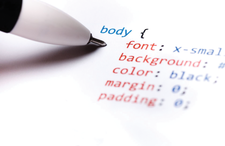Making the most out of Cascading Style Sheets
Command Line – CSS

© Lead Image © photovibes, 123RF.com
Cascading Style Sheets can provide a sophisticated layout for articles and books. Here are a few tips to get you started.
If you have created HTML or JavaScript in the last two decades, you probably have a nodding familiarity with Cascading Style Sheets (CSS) [1]. Not only is the CSS stylesheet language commonplace on the Internet, but popular ebook formats like EPUB and MOBI use it as well. Moreover, because CSS is human-readable, if you know English, you can understand much of what is being done without learning the details. However, a formal look at CSS is likely to reveal missed details, not least of which is the number of options it provides.
CSS keeps format and content separate. Initially, markup languages like HTML were designed to do the same, but the distinction became blurred (if you are old enough, you may remember the infamous HTML blink tab). CSS was intended to restore the distinction by being a stylesheet that gave designers control over how pages are viewed. CSS has been only partly successful, because different web browsers continue to display some elements differently and to allow readers to override CSS with their own preferences. All the same, CSS remains popular, if only because most designers prefer to have some formatting control.
At any rate, CSS continues to be a standard feature of modern computing. Its specifications are developed and maintained by the World Wide Web Consortium (W3C), which also provides a CSS validation service [2]. However, be aware that different CSS uses, such as ebook publication on Amazon or Lulu, often have their own, sometimes arbitrary, standards for CSS stylesheets. A given stylesheet can be valid by W3C standards yet still fail to be accepted by a given publisher. It's time, though, for a closer look at CSS constructions.
[...]
Buy this article as PDF
(incl. VAT)
Buy Linux Magazine
Subscribe to our Linux Newsletters
Find Linux and Open Source Jobs
Subscribe to our ADMIN Newsletters
Support Our Work
Linux Magazine content is made possible with support from readers like you. Please consider contributing when you’ve found an article to be beneficial.

News
-
OpenMandriva Lx 6.0 Available for Installation
The latest release of OpenMandriva has arrived with a new kernel, an updated Plasma desktop, and a server edition.
-
TrueNAS 25.04 Arrives with Thousands of Changes
One of the most popular Linux-based NAS solutions has rolled out the latest edition, based on Ubuntu 25.04.
-
Fedora 42 Available with Two New Spins
The latest release from the Fedora Project includes the usual updates, a new kernel, an official KDE Plasma spin, and a new System76 spin.
-
So Long, ArcoLinux
The ArcoLinux distribution is the latest Linux distribution to shut down.
-
What Open Source Pros Look for in a Job Role
Learn what professionals in technical and non-technical roles say is most important when seeking a new position.
-
Asahi Linux Runs into Issues with M4 Support
Due to Apple Silicon changes, the Asahi Linux project is at odds with adding support for the M4 chips.
-
Plasma 6.3.4 Now Available
Although not a major release, Plasma 6.3.4 does fix some bugs and offer a subtle change for the Plasma sidebar.
-
Linux Kernel 6.15 First Release Candidate Now Available
Linux Torvalds has announced that the release candidate for the final release of the Linux 6.15 series is now available.
-
Akamai Will Host kernel.org
The organization dedicated to cloud-based solutions has agreed to host kernel.org to deliver long-term stability for the development team.
-
Linux Kernel 6.14 Released
The latest Linux kernel has arrived with extra Rust support and more.

